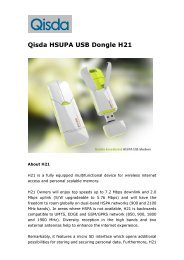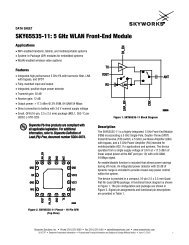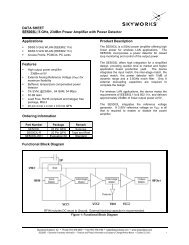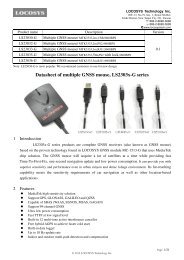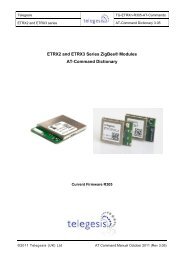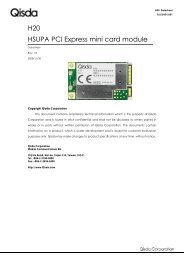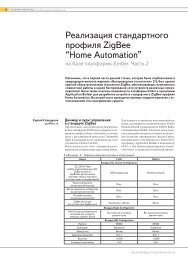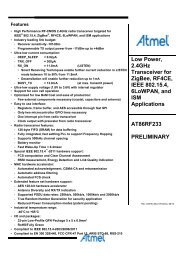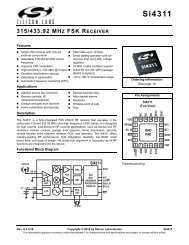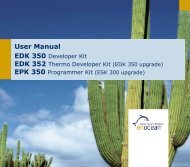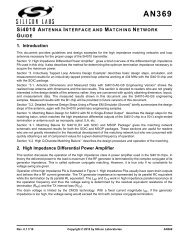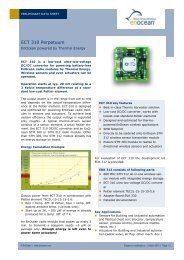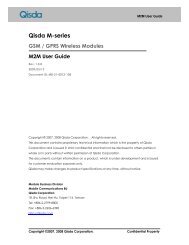AT Command Reference Guide for EDGE Wireless ... - wless.ru
AT Command Reference Guide for EDGE Wireless ... - wless.ru
AT Command Reference Guide for EDGE Wireless ... - wless.ru
Create successful ePaper yourself
Turn your PDF publications into a flip-book with our unique Google optimized e-Paper software.
Chapter 10 – Internet Service <strong>Command</strong>s<br />
10.3 <strong>AT</strong>^SISO Internet Service Open<br />
Description:<br />
Test <strong>Command</strong> Syntax:<br />
Response:<br />
Read <strong>Command</strong> Syntax:<br />
Response:<br />
Write <strong>Command</strong> Syntax:<br />
Response:<br />
Unsolicited Result Code:<br />
The <strong>AT</strong>^SISO write command starts the Internet session configured by the service<br />
profile. If the service open successfully, the URCs ^SISR and ^SISW will trigger the<br />
action to follow, either writing data with <strong>AT</strong>^SISW of reading data with <strong>AT</strong>^SISR. If the<br />
“^SISW” and “^SISR” URCs notify that no data is available at all, or that a data transfer<br />
has been successful, the service can be closed with <strong>AT</strong>^SISC. If an error occurs after<br />
opening or while using a service then the URC type “^SIS” described below will be<br />
delivered.<br />
In any case, an opened service must be finished by sending the Close command<br />
<strong>AT</strong>^SISC. This applies no matter whether the service has been completed successfully<br />
(all data transmitted) or entered an error state (e.g., indicated by the “^SIS” URC). It is<br />
also necessary when a service, such as POP3 or FTP, has already closed automatically<br />
after successful data transfer and entered “2”.<br />
The <strong>AT</strong>^SISO read command requests the status of all Internet service profiles. One<br />
line is issued <strong>for</strong> every Internet service profile. In<strong>for</strong>mation following <br />
value “srvType” is issued only if “srvType” was given a valid value via <strong>AT</strong>^SISS. The<br />
read command can be used any time during operation or after closing a service. In the<br />
latter case the response indicates the state of the last event related to a specific service<br />
profile. It will be updated only when the same service profile is used again.<br />
<strong>AT</strong>^SISO=<br />
OK<br />
<strong>AT</strong>^SISO<br />
^SISO: , value “srvType” [, , ,<br />
, , , ]<br />
OK<br />
<strong>AT</strong>^SISO=<br />
OK<br />
ERROR<br />
+CME ERROR: <br />
Indicates the current state of the Internet service.<br />
^SIS: , [, [][, ]]<br />
The URC may appear if an error occurs, <strong>for</strong> example after opening an Internet service<br />
with <strong>AT</strong>^SISO or any time during operation. The URC also indicates a request <strong>for</strong> a<br />
mobile terminated Internet service client connection, or a failure if a mobile terminated<br />
request is rejected. Furthermore, the URC may deliver an in<strong>for</strong>mation element resulting<br />
from a specific command given in the service profile.<br />
The precise related to a varies greatly depending on the used<br />
service, the scenario and the implementation of the remote server. A list of possible<br />
causes can be found in Section 10.7, Info. Elements Related to Internet Service URCs.<br />
Parameter Descriptions:<br />
<br />
0 ... 9 specified with <strong>AT</strong>^SISS.<br />
<br />
Internet service state identifier.<br />
“” Service profile is unused.<br />
2 Service profile resources are allocated; i.e., at least the service type has been set<br />
(parameter , value “srvType” of <strong>AT</strong>^SISS). The service is not opened.<br />
3 Connecting: State after opening a service with <strong>AT</strong>^SISO where the connection is being<br />
established.<br />
If connection setup is successful the service proceeds to the state “4” (Connected) and<br />
one of the URCs “^SISW” and “^SISR” may follow. If connection setup is not successful,<br />
the “^SIS” may appear.<br />
In the case of SMTP, the service will not enter =3 until the host has written<br />
the first data packet with <strong>AT</strong>^SISW.<br />
If the service profile is configured as Socket listener, then the listener always stays at<br />
=3 (listening) and =3 (LISTENER), while the and<br />
of the dynamically assigned service profile may change. See examples<br />
in Section 10.3.1.<br />
4 Connected: Socket connection valid.<br />
5 Closing: Socket connection releasing. The Closing state is reached after sending the<br />
<strong>AT</strong>^SISC command or after a service has closed automatically, such as FTP download<br />
or POP3. In the latter case, it is necessary to send the <strong>AT</strong>^SISC command even though<br />
the FTP download or POP3 service has already entered “2”.<br />
Multi-Tech Systems, Inc. <strong>AT</strong> <strong>Command</strong>s <strong>for</strong> <strong>EDGE</strong> Modems (S000371B) 134



